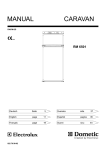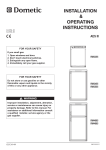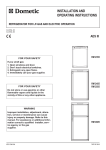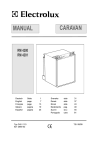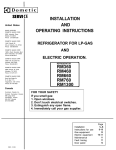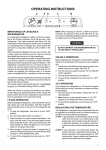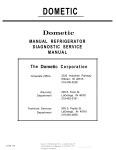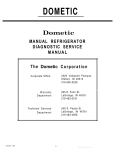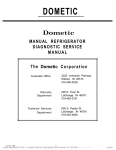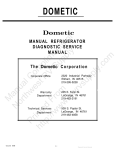Download Dometic RM 4601 Operating instructions
Transcript
MANUAL CARAVAN RA/RM-2D 0402 RM 4601 822 70 89-06 Piezo igniter version page 3 Reigniter version page 11 OPERATING AND INSTALLATION INSTRUCTIONS FOR DOMETIC REFRIGERATORS INTRODUCTION CONTENTS We are pleased that you have chosen this refrigerator and hope you will derive much satisfaction from using it, but first a few well-meant words of advice: OPERATING INSTRUCTIONS ............................ 4 CONTROLS .................................................... 4 It is important to read through these instructions carefully before using the refrigerator. STARTING THE REFRIGERATOR ................. 4 To ensure good refrigeration and economical operation, the refrigerator must be installed and used as described in these instructions. TRAVEL CATCH ............................................. 4 REGULATING THE TEMPERATURE ............. 4 FOOD STORAGE ........................................... 4 ICE-MAKING ................................................... 5 The refrigerator is designed for installation in caravans or campers. DEFROSTING ................................................. 5 TRANSIT DAMAGE TURNING OFF THE REFRIGERATOR .......... 5 Inspect the refrigerator for damage. Transit damage must be reported to whoever is responsible for delivery not later than seven days after the refrigerator was delivered. IF THE REFRIGERATOR FAILS CLEANING THE REFRIGERATOR ................ 5 TO WORK ....................................................... 5 MAINTENANCE .............................................. 6 SERVICE ......................................................... 6 DATA PLATE Check the data plate, inside the refrigerator, to ensure that you have received the right model. INSTALLATION INSTRUCTION ......................... 6 REPOSITIONING THE HINGES ..................... 6 The right gas pressure is ......................... 2.75 kPa The right voltage is .......................... 230 - 240 volts The data plate contains e. g. the following details: DOOR PANEL ................................................. 6 Model designation Product number Serial number Voltage Gas pressure LP GAS CONNECTION .................................. 8 RM 4601 .................................. .................................. .................................. volts .................................. kPa INSTALLATION/BUILDING-IN ....................... 6 VENTILATION OF THE UNIT ......................... 8 ELECTRICAL CONNECTION ........................ 9 TECHNICAL DATA ......................................... 9 POSITIONING OF SHELVES ......................... 20 Since these details will be needed if you have to contact service personnel, it is a good idea to make a note of them here. 3 OPERATING INSTRUCTIONS CONTROLS 2. Set the thermostat knob (E) to the highest setting. 3. Turn the energy selector (A) to position “GAS”. 4. Push the button (D) in until it reaches the bottom and hold, push the button (C) for the piezo igniter several times to light the burner. This can be observed on the flame indicator (B), on the refrigerator. When the flame is on, the red indicator is in the green field. 5. After the gas is lit keep the button (D) pressed for 10 seconds. Release the button (D) and check that the RED indicator is in the GREEN field. If the burner goes out, repeat the lighting procedure. 6. To shut off the refrigerator, turn the knob (A) to “OFF” position. 230-240 V operation FIG. 1 The refrigerator can be run on 230-240 V, 12 V or LP gas. Changing between these modes of operation is carried out by means of the control buttons positioned as shown in fig. 1. The energy selector (A) can be set at either “AC” (230240 V), “DC” (12 V), “GAS” (LP gas) or “OFF”. A flame indicator (B) at the control panel shows if the gas flame is lit. The gas is lit when the red indicator is in the green field. A manual piezo-electric igniter is used. When the button (C) is pushed, sparks are generated at the burner. The refrigerator is fitted with a safety device that automatically shuts off the supply of gas if the flame goes out. The safety device can be operated manually by pressing the button (D). The refrigerator temperature is controlled by a thermostat (E) when the refrigerator runs on 230-240 V and LP gas. Please note that the thermostat has no “off” position when the refrigerator runs on LP gas. STARTING THE REFRIGERATOR All references are to fig. 1. WARNING! DO NOT OPERATE THE REFRIGERATOR ON LP GAS WHILST MOBILE. TURN OFF THE GAS BOTTLE WHILST MOBILE. Before operating the refrigerator, check that the voltage stated on the data plate is the same as the main voltage in use. 1. Turn the thermostat knob (E) to its highest (coldest) position. 2. Set the energy selector (A) to position “AC”. 3. To shut off the refrigerator, turn the knob (A) to “OFF” position. 12 V operation Only operate your refrigerator on 12 V when the engine of the vehicle is running - otherwise your battery will soon be discharged. 1. Set the energy selector (A) to position “DC”. 2. Note: there is no thermostat function on 12 V operation, the refrigerator works continuously. 3. To shut off the refrigerator, turn the knob (A) to “OFF” position. REGULATING THE TEMPERATURE The position number refers to fig.1. It will take a few hours for the refrigerator to reach normal operating temperature. So we suggest you start it well in advance of a trip and if possible store it with precooled foodstuffs. On 230-240 V operation and LP gas operation the refrigerator is controlled by a thermostat and the thermostat knob (E) should be set at 3-5. If a lower (colder) temperature is desired set the thermostat to a higher figure. On 12 V operation the refrigerator works continuously. TRAVEL CATCH The travel catch is integrated in the handle. Make sure that the travel catch is engaged when the caravan is on the move. LP Gas operation FOOD STORAGE After initial installation, servicing, or changing gas cylinders etc., the gas line is likely to be filled with air. You may have to repeat the lighting procedure several times to purge the air out of the gas lines. Always keep food in closed containers. Never put hot food in the refrigerator; allow it to cool first. To start gas operation: 1. Open the shut off valve of the gas bottle (check that there is enough gas). Open any on-board shut-off valve. 4 Never keep items in the refrigerator that might give off flammable gases. The frozen food compartment is intended for the storage of frozen food and for making ice. It is not suitable for freezing items of food. Most kinds of frozen food can be stored in the frozen food compartment for about a month. This period of time may vary, however, and it is important to follow the instructions on the individual packages. The cooling unit behind the refrigerator should be cleaned with a brush from time to time, but make sure that the refrigerator is switched off when doing this. ICE MAKING TURNING OFF THE REFRIGERATOR It is practical to make ice during the night - then the refrigerator is less demanded and the cooling unit has more reserves. Fill the ice tray to just below the brim with drinking water and place it on the freezer shelf. It is possible to make ice faster by turning the thermostat knob temporarily to its highest value but do not forget to turn it back to its regular setting afterwards as the refrigerator might otherwise become too cold. If the refrigerator is not to be used for some time: 1. Set the switch (A), fig. 1, to “OFF”. 2. Shut off any on-board valve in the gas line to the refrigerator. 3. Empty the refrigerator. Defrost and clean it as described earlier. Leave the doors of the refrigerator and frozen food compartment ajar. DEFROSTING Frost will gradually accumulate on the refrigerating surfaces. It must not be allowed to grow too thick as it acts as an insulator and adversely affects refrigerator performance. Check the formation of frost regularly every week and when it gets about 3 mm thick, defrost the refrigerator. To defrost the refrigerator, turn it off and remove the ice trays and the food item, leave the cabinet and freezer doors open. Do not try to accelerate defrosting by using any kind of heating appliance, as this might damage the plastic surfaces of the refrigerator. Neither should any sharp objects be used to scrape off the ice. Defrost water runs from a drip tray to a receptacle at the rear of the refrigerator where it normally evaporates. Heavy frosts build up on the freezer plate and the cooling fins, and a lot of defrost water: Move the plastic drain tube in to a watertight bucket or container. (Access through the lower ventilation grill on the outside of the vehicle). As the frost melts, the water will flow into the container. Replace the drain tube to its original position after defrosting. Defrost water in the freezer compartment should be mopped up with a cloth. When the ice has melted, wipe the refrigerator dry and restart it. Place the food items back inside but wait until the refrigerator is cold before making ice cubes. CLEANING THE REFRIGERATOR Clean the inside of the refrigerator regularly to keep it fresh and hygienic. Soak a cloth in a solution consisting of a teaspoon of bicarbonate of soda to half a litre of warm water. Wring out the cloth and use it to clean the interior of the refrigerator and its fittings. Never use detergents, scouring powder, strongly scented products or wax polish to clean the interior of the refrigerator as they may damage the surfaces and leave a strong odour. The exterior of the refrigerator should be wiped clean now and then, using a damp cloth and a small quantity of detergent. But not the door gasket, which should only be cleaned with soap and water and then thoroughly dried. IF THE REFRIGERATOR FAILS TO WORK Check the following points before calling a service technician: 1. That the “STARTING THE REFRIGERATOR” instructions have been followed. 2. The refrigerator is level. 3. If it is possible to start the refrigerator on any of the connected sources of energy. 4. If the refrigerator fails to work on gas, check: • That the gas bottle is not empty. • That all LP-gas valves are open. 5. If the refrigerator fails to work on 12 V, check: • That the 12 V supply is connected to the refrigerator. • That the fuse on the 12 V supply is intact. • That the battery is not run down. 6. If the refrigerator fails to work on 230-240 V, check: • That the 230-240 V supply is connected to the refrigerator. • That the fuse is intact. If the refrigerator is not cooling sufficiently, the reason may be: 1. Inadequate ventilation of the cooling unit due to the intake and/or exhaust air vents being partly or completely blocked. 2. The evaporator is frosted up. 3. The thermostat setting is incorrect. 4. Gas pressure is incorrect - please check the pressure regulator on the gas container. 5. The refrigerator is not level. 6. Too much food is loaded at one time. 7. The door is not properly closed or the magnetic sealing strip is defective. If the refrigerator still does not work properly, call a service technician. WARNING! The sealed cooling system must not be opened, since it contains corroding chemicals under high pressure. 5 MAINTENANCE DOOR PANEL Always turn to a qualified service technician who is familiar with LP gas systems and refrigerator. We recommend that a service technician check the refrigerator once a year. • Check all connections in the LP gas system for gas leaks. Connections can be tested for leaks using a soap solution. Do not use a naked flame! If there is any suspicion of damage, call for a service technician. Door panels can easily be fitted or changed. The dimensions of the panels must be: Model RM 4601 Height upper door 402 ±1mm lower door 826 ±1mm Width 525 ±1mm Thickness max. 4 mm • The ventilation openings are unobstructed. • The Instruction Manual is available. • Check that the burner is clean and free from combustible material. The refrigerator is delivered with door panels. When mounting the panel, proceed as follows. See figure 8. • open the door 90 degrees • remove the door decoration strip from the door by taking out the 3 screws and remove the old panel SOME USEFUL HINTS Make sure that: • The refrigerator is not operating on 12 V when the vehicle is parked; otherwise you will drain the car battery in a short time. • Defrosting is carried out periodically • The refrigerator is clean and dry with the door left open when it is not to be used for some time. • Liquids or items with a strong odour are well packed. • The ventilation openings are unobstructed. • The door is secured by means of the travel catch when the caravan is on the move. • insert the new panel and push the panel downwards • replace the decoration strip and screws INSTALLATION/BUILDING-IN The refrigerator is intended for installation in a caravan or camper van, and the description relates to this application. The refrigerator must not be exposed to radiated heat from hot objects. It is not a good practice to install the refrigerator so that the vent openings are covered by the vehicle’s entrance door when this is set open. This would reduce the ventilation airflow to the cooling unit and reduce refrigeration performance. The enclosure SERVICE AND SPARE PARTS Service and spare parts are obtainable from your dealer or Dometic - consult the telephone directory. INSTALLATION INSTRUCTIONS GENERAL INSTRUCTION This appliance is designed for storage of foods and storage of frozen foods and making ice. The refrigerator must be installed in a substantial enclosure and must be level, the dimensions are shown in TECHNICAL DATA. The bottom of the enclosure must be horizontal and even so that the refrigerator can be easily pushed into place. It must be sturdy enough to carry the weight of the refrigerator. Make sure that there is a complete seal between the front frame of the refrigerator and top, sides and bottom of the enclosure. This appliance must be installed by an authorised person and conform to all relevant local authorities. The appliance shall be installed in accordance with the manufacturers installation instructions, local gas fitting regulations, municipal building codes, electrical wiring regulations, AS5601 “Gas Installations” and any other statutory regulations. REPOSITIONING THE HINGES The refrigerator is equipped with reversible doors. A special door reversing kit must be used to reverse the doors. For further information, contact your dealer or Dometic. FIG. 2 6 A length of sealing strip is applied to the rear surface of the front frame for this purpose, see fig. 2. Note: A wood strip must be in place across the upper opening of the enclosure. The top frame of the refrigerator will be anchored to the wood strip with screws. See fig. 6 b. Push the refrigerator into the recess until the sealing strip on the flange seals against the front of the recess, so that the cooling unit is completely sealed off against the interior of the caravan. Note: Be careful not to damage the sealing strip when the refrigerator is put in place. 2 Securing the refrigerator After the refrigerator is put in place, (insuring a combustion seal at the front frame), the refrigerator is to be secured in the enclosure with six screws. The screws have to be installed in the following order: STEP 1: Two screws installed through the front base. 1. Secure the refrigerator to the floor with two screws: One screw through the hinge and into the floor, and on the opposite side one screw through the front base. (See fig. 3). 2. A cover plate (shipped as a loose part) is to be attached after the refrigerator is secured in the enclosure. (See fig. 3). FIG. 4 1 STEP 3: Two screws installed in the rear base. See fig. 5. Failure to follow the sequence in securing the refrigerator in the enclosure can cause leakage between the frame and cabinet. Any space between the counter, storage area or ceiling and top of the refrigerator greater than 40 mm should be blocked. The heat produced at the rear of the refrigerator will become trapped in this space, making the top of the refrigerator hot and reduce the efficiency of the refrigerator. FIG. 3 STEP 2: Two screws installed in the top frame. The top decoration panel must be removed from the refrigerator before the screws can be installed. Open the upper door and gently push the tabs out of the hole in the hinge (both sides) with a flat blade screwdriver. Carefully tilt the top decoration panel and lift up to remove from top frame. See fig. 4. Install the two screws in the top frame, the holes are accessible from underneath. FIG. 5 Seal the opening for the screws with aluminium tape. Replace the top decoration panel. Make sure the tabs snap back into the holes in the hinge plate. 7 VENTILATION OF THE UNIT NOTE: Wood Strip MUST be in place Minimum ventilation height Condenser FIG. 6a FIG. 6b Ventilation heights Model Minimum ventilation heights in mm. Installation with upper and lower side vent. RM 4601 1760 Minimum ventilation height Installation with roof vent and lower side vent. 1515 At extreme ambient temperatures the refrigeration unit will only perform adequately when properly ventilated. Side ventilation The refrigerator unit is ventilated via two openings in the wall of the caravan (fig. 6b). Fresh air enters through the lower opening and warm air is discharged through the upper one. The lower opening should be located at floor level. The upper ventilation opening should be located above the condenser, as high as possible, to ensure good ventilation. Roof ventilation The ventilation of the cooling unit can also be done via one opening in the wall of the caravan and one on the roof for the roof vent (fig. 6a). Fresh air enters through the lower opening and warm air is discharged through the roof vent. Ventilation grilles We recommend fitting the Dometic ventilation system, which is specially developed by Dometic for this purpose. The Dometic ventilation grilles permit inspection and small repairs to be carried out without the necessity of removing the refrigerator from the recess. If there is no outer grille at floor level where leaking gas can escape, a 40 mm hole to the outside should be made in the floor of the recess to drain any unburned gas to the outside. Fit the hole with wire mesh and an angled plate to protect it from stones, mud etc. Removal of flue gases The ventilation passage at the rear of the recess, between the outer wall of the vehicle and the refrigerator must be sealed off against the living space, so cold draughts are excluded (winter camping) and no flue gases can penetrate into the vehicle. The flue gases are dispersed through the upper vent grille or the roof vent together with the ventilation air. The top, bottom and sides of the ventilation passage should be insulated to prevent condensation and cold draughts. LP GAS CONNECTION The refrigerator is designed for operation on LP gas, the pressure of which must be 2.75 kPa for Propane. Check that this is stated on the data plate. The refrigerator is not designed for operation on town gas or natural gas. CAUTION! Check that the gas supplied to the refrigerator is at the correct pressure. The gas installation and servicing must be carried out by an authorised person and conform to all relevant local authorities. The gas supply system must incorporate an approved gas pressure regulator to maintain a supply pressure of 2.75 kPa. 8 The supply pipe should preferable be of copper. If any other material is used, it must be of a type approved for use with continuously operating bottled-gas appliances and have threaded connections throughout. All connectors etc. should be of a type specifically designed for the type and diameter of the connection pipe used, and screwed joints should be sealed with a joining compound approved for use with bottled-gas. The gas supply pipe should be connected to the gas inlet connection at the rear of the refrigerator by means of a suitable threaded coupling. The connection nipple is furnished with an ISO 7/1 - Rp 1/8 internal pipe thread connection. In making the connection to the refrigerator, a union gas cock of an approved type bottled gas must be incorporated in the supply line in a position that is readily accessible to the user. For eventual servicing purposes, the union should be on the outlet side of the cock and the pipework should be positioned so as not to prevent the refrigerator from being readily withdrawn. All completed connections should be checked for leaks with soapy water. 12 V Supplies The 12 V connection of the refrigerator is shown in fig. 7. Connect the refrigerator to the vehicle battery or alternator by a direct cable; (check the polarity). The connection is made to the terminal block (fig. 7 “Heater”). The connection is made to the positive (+) and negative (-) terminals of the terminal block. Correct polarity must be observed when connecting to the 12 volt DC supply. Do not use the chassis or the vehicle frame as one of the conductors. Connect two wires at the refrigerator and route directly to the 12 volt DC supply. To avoid a voltage drop, the cross section area of the connecting cables between battery/alternator and the refrigerator must be 10 mm2. To ensure satisfactory operation, the positive lead must be fitted with a fuse rated at 25 A. To prevent the refrigerator from draining the battery, make sure that the current supplied to the caravan is cut off when the vehicle engine is not running, for example by fitting an ignition control relay. 12 V DC WARNING! Reigniter Lamp DO NOT use a flame to check for gas leaks. Heater On completion of installation, the system must be pressure tested by a qualified technician. ELECTRICAL CONNECTION The electrical installation must be carried out in a proper and durable manner; taking into accounts all relevant regulations and codes of practice. FIG. 7 For mains voltage operation, it is important that the circuit to and in the caravan is effectively earthed. RM 4601 Overall dimensions, refrigerator Height (incl. controls) ......................... 1427 Width ................................................. 632 Depth (incl. handle) ........................... 668 Recess dimensions Height ................................................ 1415 Width ................................................. 607 Depth ................................................. 620 Capacity Gross ................................................. 186 Net ..................................................... 171 Frozen food compartment ................. 47 Weight (without packaging) .................... 61.5 Electrical data Input 230-240 volt ....................... 325 12 volt ....................... 215 Energy consumption (in 24h) ................. 4.6 LP gas data Input, max. ........................................ 1.7 Energy consumption (in 24h) ................. 440 Cooling medium: Ammonia The refrigerator is equipped with a three-prong (grounding) plug for your protection against shock hazards and should be plugged directly into a properly grounded threeprong receptacle. DO NOT cut off or remove the grounding prong from this plug. The free length of the cord is 1.8 m and therefore recommended that the receptacle be located to the left side of the refrigerator (viewed from the rear) and approximately 100-150 mm from the floor. This allows easy access through the vent door. 230-240 V Supplies. Check that the voltage stated on the data plate is the same as the main voltage in use (230-240 V). Plug the 230-240 V refrigerator power cord into an easily accessible wall socket. Electrical leads must be routed and secured so that they cannot come into contact with hot or sharp parts of the refrigerator. TECHNICAL DATA mm mm mm mm mm mm litres litres litres kg watt watt kWh MJ/h g Sodium chromate is used for corrosion protection (less than 2 weight % of the coolant). 9 1 1 1 2 3 3 1 1 1 4 5 FIG. 8 Wiring diagram RM 4601 with piezo igniter 10 OPERATING AND INSTALLATION INSTRUCTIONS FOR DOMETIC REFRIGERATORS INTRODUCTION CONTENTS We are pleased that you have chosen this refrigerator and hope you will derive much satisfaction from using it, but first a few well-meant words of advice: OPERATING INSTRUCTIONS .......................... 12 CONTROLS .................................................. 12 STARTING THE REFRIGERATOR ............... 12 It is important to read through these instructions carefully before using the refrigerator. REGULATING THE TEMPERATURE .......... 12 TRAVEL CATCH ........................................... 12 To ensure good refrigeration and economical operation, the refrigerator must be installed and used as described in these instructions. The refrigerator is designed for installation in caravans or campers. FOOD STORAGE ......................................... 12 ICE-MAKING ................................................. 13 DEFROSTING ............................................... 13 CLEANING THE REFRIGERATOR .............. 13 TURNING OFF THE REFRIGERATOR ........ 13 TRANSIT DAMAGE Inspect the refrigerator for damage. Transit damage must be reported to whoever is responsible for delivery not later than seven days after the refrigerator was delivered. IF THE REFRIGERATOR FAILS TO WORK ..................................................... 13 MAINTENANCE ............................................ 14 SERVICE ....................................................... 14 INSTALLATION INSTRUCTION ....................... 14 DATA PLATE Check the data plate, inside the refrigerator, to ensure that you have received the right model. REPOSITIONING THE HINGES .................. 14 The right gas pressure is ......................... 2.75 kPa The right voltage is .......................... 230 - 240 volts The data plate contains e. g. the following details: INSTALLATION/BUILDING-IN ..................... 14 DOOR PANEL ............................................... 14 VENTILATION OF THE UNIT ....................... 16 LP GAS CONNECTION ................................ 16 Model designation Product number Serial number Voltage Gas pressure RM 4601 ....................................... ....................................... ....................................... volts ....................................... kPa ELECTRICAL CONNECTION ...................... 17 TECHNICAL DATA ....................................... 18 POSITIONING OF SHELVES ....................... 20 Since these details will be needed if you have to contact service personnel, it is a good idea to make a note of them here. 11 OPERATING INSTRUCTIONS CONTROLS 3. Turn the energy selector (A) to position “GAS”. A ticking sound will be heard and the lamp (B) will start flashing. 4. Push the button (C) in until it reaches the bottom and hold. This opens the flame failure device and allows gas to flow to the burner. 5. When the flame lights, the sparking stops automatically and the lamp stops flashing. 6. Hold the button (C) an additional 10-15 seconds to activate the flame failure device, then release it. If the lamp start flashing again, repeat step 4-6. 7. To shut off the refrigerator, turn the knob (A) to “OFF” position. 230-240 V operation FIG. 1 The refrigerator can be run on 230-240 V, 12 V or LP gas. Changing between these modes of operation is carried out by means of the control buttons positioned as shown in fig. 1. The energy selector (A) can be set at either “AC” (230240 V), “DC” (12 V), “GAS” (LP gas) or “OFF”. An indicator lamp (B) at the control panel flashes when the automatic igniter attempts to light the burner. Otherwise this lamp is off. The refrigerator is fitted with a safety device that automatically shuts off the supply of gas if the flame goes out. The safety device can be operated manually by pressing the button (C). Before operating the refrigerator, check that the voltage stated on the data plate is the same as the main voltage in use. 1. Turn the thermostat knob (D) to its highest (coldest) position. 2. Set the energy selector (A) to position “AC”. 3. To shut off the refrigerator, turn the knob (A) to “OFF” position. 12 V operation Only operate your refrigerator on 12 V when the engine of the vehicle is running - otherwise your battery will soon be discharged. 1. Set the energy selector (A) to position “DC”. 2. Note: there is no thermostat function on 12 V operation, the refrigerator works continuously. 3. To shut off the refrigerator, turn the knob (A) to “OFF” position. REGULATING THE TEMPERATURE The refrigerator temperature is controlled by a thermostat (D) when the refrigerator runs on 230-240 V and LP gas. Please note that the thermostat has no “off” position when the refrigerator runs on LP gas. DO NOT OPERATE THE REFRIGERATOR ON LP GAS WHILST MOBILE. The position number refers to fig.1. It will take a few hours for the refrigerator to reach normal operating temperature. So we suggest you start it well in advance of a trip and if possible store it with precooled foodstuffs. On 230-240 V operation and LP gas operation the refrigerator is controlled by a thermostat and the thermostat knob (D) should be set at 3-5. If a lower (colder) temperature is desired set the thermostat to a higher figure. On 12 V operation the refrigerator works continuously. TURN OFF THE GAS BOTTLE WHILST MOBILE. TRAVEL CATCH STARTING THE REFRIGERATOR All references are to fig. 1. WARNING! LP Gas operation After initial installation, servicing, or changing gas cylinders etc., the gas line is likely to be filled with air. You may have to repeat the lighting procedure several times to purge the air out of the gas lines. To start gas operation: 1. Open the shut off valve of the gas bottle (check that there is enough gas). Open any on-board shut-off valve. 2. Set the thermostat knob (D) to the highest setting. 12 The travel catch is integrated in the handle. Make sure that the travel catch is engaged when the caravan is on the move. FOOD STORAGE Always keep food in closed containers. Never put hot food in the refrigerator; allow it to cool first. Never keep items in the refrigerator that might give off flammable gases. The frozen food compartment is intended for the storage of frozen food and for making ice. It is not suitable for freezing items of food. Most kinds of frozen food can be stored in the frozen food compartment for about a month. This period of time may vary, however, and it is important to follow the instructions on the individual packages. The cooling unit behind the refrigerator should be cleaned with a brush from time to time, but make sure that the refrigerator is switched off when doing this. ICE MAKING If the refrigerator is not to be used for some time: 1. Set the switch (A), fig. 1, to “OFF”. 2. Shut off any on-board valve in the gas line to the refrigerator. 3. Empty the refrigerator. Defrost and clean it as described earlier. Leave the doors of the refrigerator and frozen food compartment ajar. It is practical to make ice during the night - then the refrigerator is less demanded and the cooling unit has more reserves. Fill the ice tray to just below the brim with drinking water and place it on the freezer shelf. It is possible to make ice faster by turning the thermostat knob temporarily to its highest value but do not forget to turn it back to its regular setting afterwards as the refrigerator might otherwise become too cold. DEFROSTING Frost will gradually accumulate on the refrigerating surfaces. It must not be allowed to grow too thick as it acts as an insulator and adversely affects refrigerator performance. Check the formation of frost regularly every week and when it gets about 3 mm thick, defrost the refrigerator. To defrost the refrigerator, turn it off and remove the ice trays and the food item, leave the cabinet and freezer doors open. Do not try to accelerate defrosting by using any kind of heating appliance, as this might damage the plastic surfaces of the refrigerator. Neither should any sharp objects be used to scrape off the ice. Defrost water runs from a drip tray to a receptacle at the rear of the refrigerator where it normally evaporates. Heavy frosts build up on the freezer plate and the cooling fins, and a lot of defrost water: Move the plastic drain tube in to a watertight bucket or container. (Access through the lower ventilation grill on the outside of the vehicle). As the frost melts, the water will flow into the container. Replace the drain tube to its original position after defrosting. Defrost water in the freezer compartment should be mopped up with a cloth. When the ice has melted, wipe the refrigerator dry and restart it. Place the food items back inside but wait until the refrigerator is cold before making ice cubes. CLEANING THE REFRIGERATOR Clean the inside of the refrigerator regularly to keep it fresh and hygienic. Soak a cloth in a solution consisting of a teaspoon of bicarbonate of soda to half a litre of warm water. Wring out the cloth and use it to clean the interior of the refrigerator and its fittings. Never use detergents, scouring powder, strongly scented products or wax polish to clean the interior of the refrigerator as they may damage the surfaces and leave a strong odour. The exterior of the refrigerator should be wiped clean now and then, using a damp cloth and a small quantity of detergent. But not the door gasket, which should only be cleaned with soap and water and then thoroughly dried. TURNING OFF THE REFRIGERATOR IF THE REFRIGERATOR FAILS TO WORK Check the following points before calling a service technician: 1. That the “STARTING THE REFRIGERATOR” instructions have been followed. 2. The refrigerator is level. 3. If it is possible to start the refrigerator on any of the connected sources of energy. 4. If the refrigerator fails to work on gas, check: • That the gas bottle is not empty. • That all LP-gas valves are open. 5. If the refrigerator fails to work on 12 V, check: • That the 12 V supply is connected to the refrigerator. • That the fuse on the 12 V supply is intact. • That the battery is not run down. 6. If the refrigerator fails to work on 230-240 V, check: • That the 230-240 V supply is connected to the refrigerator. • That the fuse is intact. If the refrigerator is not cooling sufficiently, the reason may be: 1. Inadequate ventilation of the cooling unit due to the intake and/or exhaust air vents being partly or completely blocked. 2. The evaporator is frosted up. 3. The thermostat setting is incorrect. 4. Gas pressure is incorrect - please check the pressure regulator on the gas container. 5. The refrigerator is not level. 6. Too much food is loaded at one time. 7. The door is not properly closed or the magnetic sealing strip is defective. If the refrigerator still does not work properly, call a service technician. WARNING! The sealed cooling system must not be opened, since it contains corroding chemicals under high pressure. 13 MAINTENANCE DOOR PANEL Always turn to a qualified service technician who is familiar with LP gas systems and refrigerator. We recommend that a service technician check the refrigerator once a year. • Check all connections in the LP gas system for gas leaks. Connections can be tested for leaks using a soap solution. Do not use a naked flame! If there is any suspicion of damage, call for a service technician. Door panels can easily be fitted or changed. The dimensions of the panels must be: Model RM 4601 Height upper door 402 ±1mm lower door 826 ±1mm Width 525 ±1mm Thickness max. 4 mm • The ventilation openings are unobstructed. • The Instruction Manual is available. • Check that the burner is clean and free from combustible material. The refrigerator is delivered with door panels. When mounting the panel, proceed as follows. See figure 8. • open the door 90 degrees • remove the door decoration strip from the door by taking out the 3 screws and remove the old panel SOME USEFUL HINTS Make sure that: • The refrigerator is not operating on 12 V when the vehicle is parked; otherwise you will drain the car battery in a short time. • Defrosting is carried out periodically • The refrigerator is clean and dry with the door left open when it is not to be used for some time. • Liquids or items with a strong odour are well packed. • The ventilation openings are unobstructed. • The door is secured by means of the travel catch when the caravan is on the move. • insert the new panel and push the panel downwards • replace the decoration strip and screws INSTALLATION/BUILDING-IN The refrigerator is intended for installation in a caravan or camper van, and the description relates to this application. The refrigerator must not be exposed to radiated heat from hot objects. It is not a good practice to install the refrigerator so that the vent openings are covered by the vehicle’s entrance door when this is set open. This would reduce the ventilation airflow to the cooling unit and reduce refrigeration performance. SERVICE AND SPARE PARTS The enclosure Service and spare parts are obtainable from your dealer or Dometic - consult the telephone directory. The refrigerator must be installed in a substantial enclosure and must be level, the dimensions are shown in TECHNICAL DATA. The bottom of the enclosure must be horizontal and even so that the refrigerator can be easily pushed into place. It must be sturdy enough to carry the weight of the refrigerator. Make sure that there is a complete seal between the front frame of the refrigerator and top, sides and bottom of the enclosure. INSTALLATION INSTRUCTIONS GENERAL INSTRUCTION This appliance is designed for storage of foods and storage of frozen foods and making ice. This appliance must be installed by an authorised person and conform to all relevant local authorities. The appliance shall be installed in accordance with the manufacturers installation instructions, local gas fitting regulations, municipal building codes, electrical wiring regulations, AS5601 “Gas Installations” and any other statutory regulations. REPOSITIONING THE HINGES The refrigerator is equipped with reversible doors. A special door reversing kit must be used to reverse the doors. For further information, contact your dealer or Dometic. FIG. 2 14 A length of sealing strip is applied to the rear surface of the front frame for this purpose, see fig. 2. Note: A wood strip must be in place across the upper opening of the enclosure. The top frame of the refrigerator will be anchored to the wood strip with screws. See fig. 6 b. Push the refrigerator into the recess until the sealing strip on the flange seals against the front of the recess, so that the cooling unit is completely sealed off against the interior of the caravan. Note: Be careful not to damage the sealing strip when the refrigerator is put in place. 2 Securing the refrigerator After the refrigerator is put in place, (insuring a combustion seal at the front frame), the refrigerator is to be secured in the enclosure with six screws. The screws have to be installed in the following order: STEP 1: Two screws installed through the front base. 1. Secure the refrigerator to the floor with two screws: One screw through the hinge and into the floor, and on the opposite side one screw through the front base. (See fig. 3). 2. A cover plate (shipped as a loose part) is to be attached after the refrigerator is secured in the enclosure. (See fig. 3). FIG. 4 1 STEP 3: Two screws installed in the rear base. See fig. 5. Failure to follow the sequence in securing the refrigerator in the enclosure can cause leakage between the frame and cabinet. Any space between the counter, storage area or ceiling and top of the refrigerator greater than 40 mm should be blocked. The heat produced at the rear of the refrigerator will become trapped in this space, making the top of the refrigerator hot and reduce the efficiency of the refrigerator. FIG. 3 STEP 2: Two screws installed in the top frame. FIG. 5 The top decoration panel must be removed from the refrigerator before the screws can be installed. Open the upper door and gently push the tabs out of the hole in the hinge (both sides) with a flat blade screwdriver. Carefully tilt the top decoration panel and lift up to remove from top frame. See fig. 4. Install the two screws in the top frame, the holes are accessible from underneath. Seal the opening for the screws with aluminium tape. Replace the top decoration panel. Make sure the tabs snap back into the holes in the hinge plate. 15 VENTILATION OF THE UNIT NOTE: Wood Strip MUST be in place Minimum ventilation height Condenser FIG. 6a FIG. 6b Ventilation heights Model Minimum ventilation heights in mm. Installation with upper and lower side vent. RM 4601 1760 Minimum ventilation height Installation with roof vent and lower side vent. 1515 At extreme ambient temperatures the refrigeration unit will only perform adequately when properly ventilated. Side ventilation The refrigerator unit is ventilated via two openings in the wall of the caravan (fig. 6b). Fresh air enters through the lower opening and warm air is discharged through the upper one. The lower opening should be located at floor level. The upper ventilation opening should be located above the condenser, as high as possible, to ensure good ventilation. Roof ventilation The ventilation of the cooling unit can also be done via one opening in the wall of the caravan and one on the roof for the roof vent (fig. 6a). Fresh air enters through the lower opening and warm air is discharged through the roof vent. Ventilation grilles We recommend fitting the Dometic ventilation system, which is specially developed by Dometic for this purpose. The Dometic ventilation grilles permit inspection and small repairs to be carried out without the necessity of removing the refrigerator from the recess. If there is no outer grille at floor level where leaking gas can escape, a 40 mm hole to the outside should be made in the floor of the recess to drain any unburned gas to the outside. Fit the hole with wire mesh and an angled plate to protect it from stones, mud etc. Removal of flue gases The ventilation passage at the rear of the recess, between the outer wall of the vehicle and the refrigerator must be sealed off against the living space, so cold draughts are excluded (winter camping) and no flue gases can penetrate into the vehicle. The flue gases are dispersed through the upper vent grille or the roof vent together with the ventilation air. The top, bottom and sides of the ventilation passage should be insulated to prevent condensation and cold draughts. LP GAS CONNECTION The refrigerator is designed for operation on LP gas, the pressure of which must be 2.75 kPa for Propane. Check that this is stated on the data plate. The refrigerator is not designed for operation on town gas or natural gas. CAUTION! Check that the gas supplied to the refrigerator is at the correct pressure. The gas installation and servicing must be carried out by an authorised person and conform to all relevant local authorities. The gas supply system must incorporate an approved gas pressure regulator to maintain a supply pressure of 2.75 kPa. 16 The supply pipe should preferable be of copper. If any other material is used, it must be of a type approved for use with continuously operating bottled-gas appliances and have threaded connections throughout. All connectors etc. should be of a type specifically designed for the type and diameter of the connection pipe used, and screwed joints should be sealed with a joining compound approved for use with bottled-gas. The gas supply pipe should be connected to the gas inlet connection at the rear of the refrigerator by means of a suitable threaded coupling. The connection nipple is furnished with an ISO 7/1 - Rp 1/8 internal pipe thread connection. In making the connection to the refrigerator, a union gas cock of an approved type bottled gas must be incorporated in the supply line in a position that is readily accessible to the user. For eventual servicing purposes, the union should be on the outlet side of the cock and the pipework should be positioned so as not to prevent the refrigerator from being readily withdrawn. All completed connections should be checked for leaks with soapy water. 12 V Supplies The 12 V connection of the refrigerator is shown in fig. 7. Connect the refrigerator to the vehicle battery or alternator by a direct cable; (check the polarity). The connection is made to the terminal block (fig. 7 “Heater”). The connection is made to the positive (+) and negative (-) terminals of the terminal block. Correct polarity must be observed when connecting to the 12 volt DC supply. Do not use the chassis or the vehicle frame as one of the conductors. Connect two wires at the refrigerator and route directly to the 12 volt DC supply. To avoid a voltage drop, the cross section area of the connecting cables between battery/alternator and the refrigerator must be 10 mm2. To ensure satisfactory operation, the positive lead must be fitted with a fuse rated at 25 A. To prevent the refrigerator from draining the battery, make sure that the current supplied to the caravan is cut off when the vehicle engine is not running, for example by fitting an ignition control relay. WARNING! DO NOT use a flame to check for gas leaks. On completion of installation, the system must be pressure tested by a qualified technician. ELECTRICAL CONNECTION The electrical installation must be carried out in a proper and durable manner; taking into accounts all relevant regulations and codes of practice. 12 V supply of reigniter and interior light The reigniter and the interior light must be connected to a separate 12 V battery. Connect the battery to the terminal block (fig. 7 “Reigniter, Lamp”). Be careful not to make the wrong positive and negative connections. The reigniter should not be connected directly to a battery charger but only over a battery. Interior light - bulb - change For mains voltage operation, it is important that the circuit to and in the caravan is effectively earthed. The refrigerator is equipped with a three-prong (grounding) plug for your protection against shock hazards and should be plugged directly into a properly grounded threeprong receptacle. DO NOT cut off or remove the grounding prong from this plug. The free length of the cord is 1.8 m and therefore recommended that the receptacle be located to the left side of the refrigerator (viewed from the rear) and approximately 100-150 mm from the floor. This allows easy access through the vent door. If the bulb has to be replaced, proceed as follows: 1. Remove the cover from the lamp body by pushing it backwards. 2. Remove the bulb. 3. Put in a new bulb (12 V, max. 5 W). Spare part number for bulb: 200 72 90-03. 4. Push the lamp cover back in place. 12 V DC 230-240 V Supplies. Reigniter Lamp Check that the voltage stated on the data plate is the same as the main voltage in use (230-240 V). Plug the 230-240 V refrigerator power cord into an easily accessible wall socket. Electrical leads must be routed and secured so that they cannot come into contact with hot or sharp parts of the refrigerator. Heater FIG. 7 17 TECHNICAL DATA RM 4601 Overall dimensions, refrigerator Height (incl. controls) ......................... 1427 Width ................................................. 632 Depth (incl. handle) ........................... 668 Recess dimensions Height ................................................ 1415 Width ................................................. 607 Depth ................................................. 620 Capacity Gross ................................................. 186 Net ..................................................... 171 Frozen food compartment ................. 47 Weight (without packaging) .................... 61.5 Electrical data Input 230-240 volt ....................... 325 12 volt ........................ 215 Energy consumption (in 24h) .................. 4.6 LP gas data Input, max. ......................................... 1.7 Energy consumption (in 24h) .................. 440 Cooling medium: Ammonia mm mm mm mm mm mm litres litres litres kg watt watt kWh MJ/h g Sodium chromate is used for corrosion protection (less than 2 weight % of the coolant). 1 1 1 2 3 3 1 1 1 4 FIG. 8 18 5 Wiring diagram RM 4601 with reigniter 19 Positioning of shelves 20 MO-M 0540




















